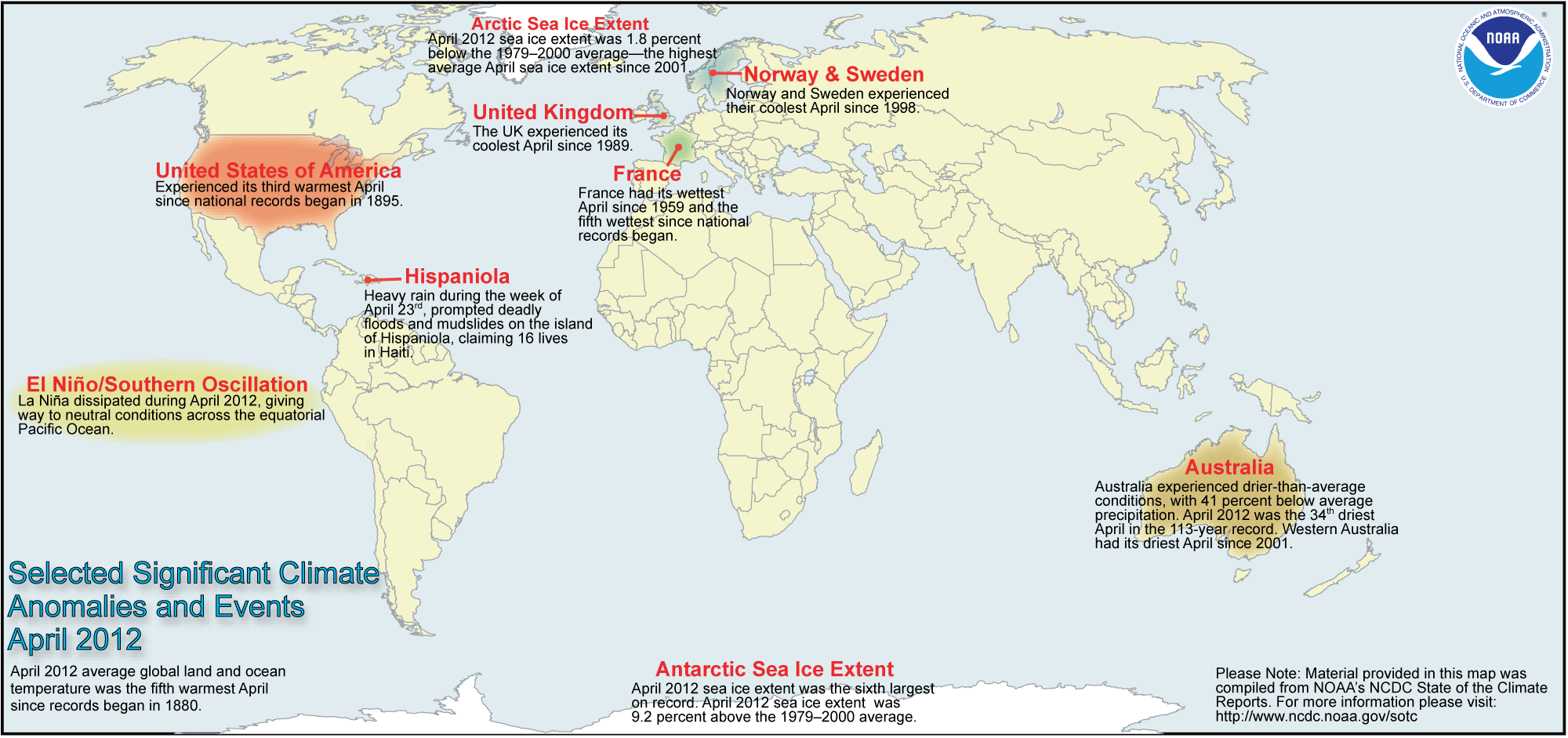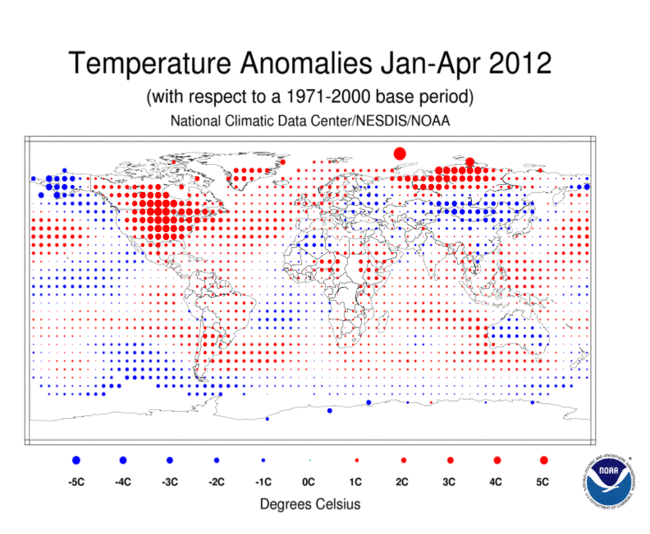Monthly Report Summary Information
The Monthly Report Summary Information is a synopsis of the collection of national and global summaries released each month.
Global Summary Information - April 2012
See Full Report
April global temperatures are fifth warmest
La Niña ends; neutral conditions return over the equatorial Pacific Ocean
The globally-averaged temperature for April marked the fifth warmest April since record keeping began in 1880. April 2012 also marked the largest departure from the 20th century average temperature in more than a year.
La Niña, typically associated with cooler global temperatures, dissipated and transitioned to neutral conditions during April as sea surface temperatures continued to warm across the equatorial Pacific Ocean. According to NOAA's Climate Prediction Center, neutral conditions are expected to continue through the Northern Hemisphere.s summer.
Global temperature highlights: April
- The combined average temperature over global land and ocean surfaces for April was 57.87°F (14.35°C), 1.17°F (0.65°C) above the 20th century average of 56.7°F (13.7°C). The margin of error associated with this temperature is ±0.14°F (0.08°C).
- The global temperature departure from the 20th century average and monthly rank were the highest since November 2010, near the onset of first of the back-to-back La Niñas in 2010.
- Driven by very warm land-surface temperatures, April 2012 was the warmest April on record for the Northern Hemisphere.
- This was the 36th consecutive April and 326th consecutive month with a global temperature above the 20th century average. The last April with below average temperature was April 1976. The last month with a below-average temperature was February 1985.
- The global land surface temperature was 2.5°F (1.39°C) above the 20th century average of 46.5°F (8.1°C), making it second warmest April, behind 2007. The margin of error is ±0.20°F (0.11°C). Warmer than average conditions engulfed much of the world.s land areas with the most notable warmth across Alaska, the contiguous United States, Mexico and most of Russia. Cooler than average conditions were present across northern Australia and parts of western Europe.
- Norway and Sweden experienced their coolest April since 1998.
- The United Kingdom experienced below-average temperatures, which resulted in the coolest April since 1989.
- The contiguous United States had its third warmest April since national records began in 1895.
- For the ocean, the April global sea surface temperature was 0.68°F (0.38°C) above the 20th century average of 60.9°F (16.0°C), ranking it 11th warmest. The margin of error is ±0.07°F (0.04°C). This was the 427th consecutive month with ocean temperatures above the 20th century average.
Global temperature highlights: Year to date
- For January through April, the combined global land and ocean average surface temperature was 0.83°F (0.46°C) above the 20th century average of 54.8°F (12.6°C), marking the 15th warmest such period on record, although coolest since 2008. The margin of error is ±0.16°F (0.09°C).
- The January.April worldwide land surface temperature was 1.35°F (0.75°C) above the 20th century average of 40.5°F (4.8°C), tying with 2011 as 17th warmest such period on record and coolest January.April since 1997. The margin of error is ±0.40°F (0.22°C). The global ocean surface temperature for the year to date was 0.63°F (0.35°C) above the 20th century average of 60.7°F (15.9°C) and tied with 1999 as 13th warmest such period on record and the coolest since 2008. The margin of error is ±0.07°F (0.04°°C).
Polar sea ice and precipitation highlights
- The average Arctic sea ice extent during April was 1.8 percent below average, ranking as the 17th largest April extent since satellite records began in 1979 and the highest average April sea ice extent since 2001.
- On the opposite pole, Antarctic sea ice during April was 9.2 percent above average and ranked as the sixth largest April extent in the 34-year period of record.
- The Northern Hemisphere snow cover extent during April 2012 was much-below average, and ranked as the fourth smallest April snow cover extent in the 46-year period of record. Both the Eurasian and North American April snow cover extents were below average, ranking seventh and eighth smallest on record, respectively.
- Precipitation was variable across the globe during April. Above-average precipitation fell over areas that include most of Europe, southern Brazil, the central United States, and parts of eastern Asia. Below-average precipitation was observed across eastern Brazil, the eastern United States, and southern parts of South America and Australia
 NOAA's National Centers for Environmental Information
NOAA's National Centers for Environmental Information




